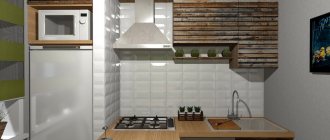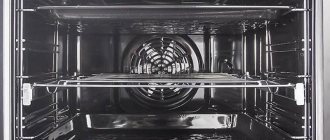Why shouldn't you place the refrigerator next to the stove?
There are a lot of arguments against it, ranging from the usual loss of comfort to premature failure of the refrigerator. Moreover, we draw your attention to the fact that there is no difference whether you place the refrigerator next to a gas stove or an electric one. Their sides heat up equally, especially if we are talking about a working oven. But, let's take it in order.
The heat from the stove makes the refrigerator work at its limit.
Some people think that proximity to a hot stove can lead to the fact that the refrigerator compartment will not cool very well, and that’s all. Or rather, temporarily warm up from the heat. That is, it’s worth revving up a little and the problem will be solved.
But it's not that simple. It's just the opposite. The warmer it is around, the more intensely the compressor generates cold... And the optimal temperature in the refrigerator will not drop, no. But this state of affairs is not at all useful for the technology itself.
The refrigerator is designed to automatically turn on the compressor at certain intervals. But when the outside temperature rises, the compressor is simply forced to work hard to maintain the desired temperature.
Naturally, the service life of the equipment in this case is reduced many times over. Especially if you have a large family and the stove runs very often. Heat the same kettle five times a day, cook some soup, heat up some dish...
And, even if you just fried eggs, the side of the stove does not heat up and cool down as quickly as it seems. The heat, accordingly, first reaches the adjacent side of the refrigerator and maintains an elevated temperature for a long time.
And the compressor turns on and on, without breaks for lunch and dinner. And even without smoking breaks.
However, this is all written in the instructions for the refrigerator. But, if you don’t believe it, you can ask any workshop and the specialist’s answer will be unequivocal: you shouldn’t do that.
Although, if you are so rich that you change refrigerators like gloves, then why not? The compressor will “fly” in five years (or even a little earlier) - buy new equipment, and that’s the end of it.
IMPORTANT - check the walls
One of the key components of the refrigerator is the capacitor. Freon circulates in it, which takes heat from inside the refrigerator or freezer and releases it outside. Therefore, it is important that there is free access of air to the condenser grille.
Most refrigerators have a condenser on the back wall. But there are models in which it is located on the side. You can't tell it by eye; the tubes are hidden behind the wall. It is better to see their location in the instructions. But if you notice that the side walls of the refrigerator are heating up, then the condenser coil is located in them.
In this case, you need to leave a gap of at least 50 mm between the walls and the furniture. if this is not done, then:
- The refrigerator will cool food more slowly.
- The compressor will turn on more often and consume more electricity.
- The service life of the refrigerator will be reduced.
- The risk of compressor failure will increase significantly.
Electricity bills
And not only are you simply “killing” the motor of your refrigerator, you are also regularly overpaying for light. The refrigerator already drags a lot without this, but if you force it to work 5-6 times more intensely, you yourself understand how much money it will cost.
After all, in order to cool the chamber, the refrigerator needs electricity to “jerk”. So think about whether it is beneficial to arrange kitchen elements this way. But, if you are rich, this argument will not convince you. Then maybe the next one will seem sane?
Correct location
Even understanding why it is impossible to place a refrigerator and a stove next to each other, some find no other way out. To minimize losses from an unfortunate neighborhood, it is useful for owners of a small kitchen to consult with a specialist. He will tell you what the minimum distance from the gas stove to the refrigerator is allowed.
To protect the refrigeration unit from exposure to high temperatures from the stove, it is enough that they are separated by at least 15-20 cm. Although some manufacturers give their recommendations on this matter. Some models cannot be placed closer to gas stoves than 50 cm. The permitted distance between the refrigerator and the electric stove is about 5 cm.
If a refrigeration unit breaks down, the service department can reasonably refuse free repairs if the operating conditions are not met. These include the location of a refrigeration device too close to a heating device, which supplies a lot of heat when turned on.
If you simply leave a gap between two types of kitchen appliances, it will not look particularly aesthetically pleasing. And if there is not enough space in the kitchen, then it is also irrational. A good solution could be to make a small custom cabinet. It is not suitable for storing groceries, but it can contain household chemicals and improvised cleaning products.
Food spoilage
Such “swings” are not in vain for the internal microclimate of the refrigerator chamber. There is no stability of cooling, you understand, therefore, there is no way to maintain an even temperature.
And as a result, sometimes the food will simply freeze. This is especially bad for fresh vegetables, fruits, and herbs. After a bunch of parsley is covered with a thin crust of ice, the smell will almost disappear and there will be almost no taste left.
Also, red caviar really doesn’t like freezing. It tastes completely different and becomes deformed.
Of course, this will not happen right away, but after a couple of years of operation of the equipment in a similar mode. And further! The freezer will also become covered with ice. And you will have to clean it much more often than under normal conditions.
Regulatory preparation
To avoid problems, study the relevant document - SNiP 2.04.08-87*. It is necessary to arrange natural supply and exhaust ventilation in the room where the stove is located (to organize air exchange). This means that it is impossible to equip a room in a room without a window with working vents, as well as without a ventilation duct with satisfactory exhaust.
It is unacceptable to cut the stopcock from the pipe; this is an integral element of the gas system. You cannot even replace flexible hoses yourself, much less organize the movement or extension of pipes. This is only done by a gas service employee.
But at the stage of negotiations with specialists, clarify what you need to purchase for the transfer. A bellows hose may be necessary. The installers will bring the metal pipes themselves, but their cost is included in the estimate for moving the slab. If you free the kitchen in advance of unnecessary furniture and objects that interfere with the dismantling process, it will be easier for the craftsmen to work. They usually announce all the requirements before coming to the house.
The advent of flexible long gas lines has led to the fact that the internal gas pipeline began to be moved much less frequently. But the issue still remains unique, and gas service representatives regularly face such requests. If you need such a service, don’t even think about unauthorized actions - at the very least, this could result in a fine. But the situation can lead to tragedy, which is much more dangerous.
Difficulty in dealing with greasy drops on the walls of the refrigerator
Another minus. At first it seems: what’s wrong with that? I’ll cook it and immediately wipe off the splashes. But, as always happens, you immediately become too lazy to wipe it off, the drops dry up tightly, and then look ugly against the backdrop of the snow-white side of the refrigerator...
But getting rid of them is now not so easy, because the delicate enamel of the refrigerator is not like a ceramic “apron” on the wall, and it will not withstand friction with an iron brush.
In general, you will have to keep an eye on this matter all the time and do not forget to wipe it right away. And this is no longer good, it’s annoying.
Of course, if you have absolutely no other way to place the elements, then we will tell you how to protect the refrigerator from grease. But, nevertheless, we insist that you think carefully again.
Useful tips
It is strictly forbidden to install a refrigerator near heating appliances.
A few recommendations to help extend the life of the unit:
- It is undesirable to install in places where direct sunlight will constantly fall;
- the optimal temperature regime for operation of the refrigeration device is from 14 to 35°C;
- cannot be installed near heating devices;
- When installing a protective sheet on the back of the refrigerator, you need to leave a distance (at least 2 cm) so that air is supplied properly.
There should be a space of at least 5 cm between the refrigerator and the wall.
It is necessary to leave free space from the device to the wall. It should be at least 5 cm. Dust should also be removed from the back wall periodically.
Correct installation and operation are the key to long-term operation of the refrigerator.
The refrigerator is a faithful friend and assistant to any housewife. For full operation, it is important to properly care for the unit and follow all safety precautions. By adhering to the parameters of the distance between the stove and the refrigeration equipment, not only the appearance, but also its functionality will be preserved.
And finally: Feng Shui is against it!
For a snack of all the minuses - here's the opinion of Feng Shui. For some reason, the refrigerator is considered an object that personifies the element of Water. But the stove is Fire. And these two things do not get along with each other, which means they bring a negative aura into the house, thicken the climate of your apartment and fill it with alarming fluctuations...
So, if there is a quarrel in your house, know: it’s all to blame for the refrigerator, which you, without thinking, placed next to the stove.
Conclusions and useful video on the topic
You can see ideas for placing a refrigerator and a stove in a small kitchen in the video below:
Manufacturers of household appliances do not recommend installing a refrigerator and a household gas stove next to each other; the ideal option is in different corners of the room.
The distance between appliances depends on the refrigerator model. The minimum is 25 centimeters. But not every kitchen can afford such placement.
Therefore, in the article we examined existing options for thermal insulation of refrigerators, which can protect against the negative consequences of overheating.
How did you decide to place these two extremely important types of household appliances in your kitchen? Share interesting ideas with other users, add photos of your kitchen, participate in discussions, ask questions - the contact form is located below the article.
What are the alternatives for placing a refrigerator?
If you are deeply moved by our beliefs, then you need to abandon this idea and look for another place for the refrigerator.
Unfortunately, we don’t know your layout, but for some reason we assume that your kitchenette is very small, which means, most likely, you are the owner of a Khrushchev-era apartment.
So, if this is the case, then it really is bad. There are no adjacent storage rooms in a niche in which you can put a refrigerator, nor a balcony that can be combined with the kitchen and take equipment there.
But on the other hand, there is a wonderful advantage in Khrushchev apartments - the interior partitions there are not concrete or load-bearing. Therefore, if your refrigerator does not fit on the opposite wall, then you can simply make a small opening in the wall between the kitchen and living room and build a niche from it.
This way, the kitchen will remain uncluttered, the refrigerator door will be flush with the wall, but a washing machine can be installed in its place. This, after all, is also the problem of Khrushchev apartments, with their two-meter bathtubs.
And the fact that in the living room the wall will not be flat, but with a difference, is even interesting. You can decorate the ledge in any way you like, hang pictures or shelves on it.
Also: when looking for another place for the refrigerator, do not forget that it is not recommended to place it not only next to the stove, but also to the radiator. It will be the same, or even worse. Heating in this case is seasonal, but continuous for many months.
The same goes for the gas pipe. It gets warm, which means it is a bad neighbor for the refrigerator and it has no place near it.
How to separate the refrigerator from the stove?
The negative consequences of such an arrangement can be reduced not only by maintaining the minimum distance and space between the mini-cabinets, but also by installing a special heat-resistant partition. The insulation sheet can be made of various materials: chipboard, mineral fiber, foam plastic, plasterboard, reeds, cork. All of them are distinguished by their properties of resistance to humidity and high temperature. It is recommended to attach them with double-sided tape to the wall of the refrigerator.
How to minimize the risk of proximity between a stove and a refrigerator?
If you have reached this block, then you are definitely not impressed by our “horror stories” and our rationale for moving the refrigerator did not find a response in your soul.
Well, if you really want to put these two things next to each other, then you definitely need to separate them somehow, at least with some small partition. Of course, the thicker the insulation, the better, but rather than nothing at all, a thin piece of some material is still better.
We will give you examples of the most popular options, and you can choose which one you like best.
Before we start looking at thermal insulation using examples, I would like to note this:
There is no point in attaching a shield that will be located between the stove and the refrigerator.
Or rather, fix it “tightly”, for example, with strong glue, such as “liquid nails”, since, who knows, you might someday have a rearrangement and this piece of slab will interfere?
It is best to buy double-sided tape, it holds very firmly and use it to glue the shield to the surface of the refrigerator. Yes, exactly the refrigerator, because the heating side of the stove will simply melt this glue and nothing will stick.
So let's look at protection options.
Successful options for placing a refrigeration unit in the kitchen
When the kitchen is large, it can be divided into separate zones
. To avoid all these unpleasant consequences, you need to decide in advance on the place where the refrigerator will be installed. If the kitchen is quite large, you can place several cabinets for storing food between the refrigerator, stove or oven.
In small spaces, the main thing is convenience and ergonomics
For small rooms, it is best to install the refrigerator against the opposite wall. In this case, the necessary operating conditions will be observed, and at the same time, everything necessary will be nearby, which will make the cooking process faster and more comfortable.
The thicker the insulating layer between the refrigerator and the oven or stove, the better
For very small kitchens, when there are no alternatives and you have to place all kitchen appliances next to each other, it is necessary to use additional insulation. This will minimize damage caused to the refrigerator by high temperatures emanating from the oven or stove.
Protective screen made of simple chipboard
You can simply buy a piece of laminated chipboard and place it between the stove and the refrigerator. Just do not forget that the side cut will need to be treated with adhesive tape, and this must be ordered at the place where the sheets are cut.
Be sure to choose a sheet to match the kitchen furniture. It would be ideal if it were exactly the same as the main body of the kitchen.
Of course, this shield will not last forever, because chipboard is afraid of hot and moisture, which means that in a few years it may lose its appearance. But such a thing is very inexpensive and we think you won’t go broke if you have to buy another sheet in a couple of years.
What distance should it be?
If the situation is hopeless, and the kitchen space does not allow these multi-directional appliances to be placed far enough apart from each other, then it is worth considering the generally accepted minimum distance between them of 15 centimeters. A cabinet with a width of 25–30 cm will fit practically and beautifully into this space. You can put kitchen accessories in it: sponges, rags, and so on. Or place a grille to create a minibar.
Protective screen with foil, mirror and glass
And this is an absolutely wonderful option. Foil or mirror perfectly reflects heat, and such a partition can be much thinner than other options. The only negative is that the mirror reflection is out of place; it can be removed using corrugated glass placed on top.
This is the most expensive method, but it is also the most effective. The refrigerator will hardly feel any heat from the stove, which means it will serve you faithfully for much longer. In any case, heat reflection is better than simple thermal insulation.
But if you combine these two methods, it will be completely good. That is, put a thick shield and stick foil on top of it.
In conclusion, I would like to say: now you know everything and even more on the topic. But the decision is yours, we just advise and hope that our considerations benefit you.
More protection, less risks
If you place the refrigerator close to the gas stove, problems cannot be avoided. While cooking, it will heat up its “neighbor”. The device will begin to cool unevenly, causing wear and tear. Electricity consumption will increase significantly, and the service life of the refrigerator will be reduced. The wall next to the stove will become covered with a layer of greasy and oily droplets.
Manufacturers recommend leaving at least 50 cm between the stove and the refrigerator. Separate them with a custom kitchen cabinet or cabinet. They will protect household appliances from heating and become additional places for storing food and utensils.
Attention! The greater the distance from the stove to the refrigerator, the less harmful the effect on it.
If there is no other option, make a partition between the “neighbors” from plasterboard or aerated concrete. To make it fit into the interior, decorate it to your liking. Tempered glass is suitable for a protective wall.
Features of placing a refrigerator next to a gas stove
In order for a household appliance to work properly, it must be provided with a suitable microclimate. The technology provides for certain operating rules. It must operate at a suitable temperature.
Compliance with the rules of operation of the refrigerator is the key to the longevity of the device.
It is not advisable to place the refrigerator next to appliances such as a gas, electric stove or oven. If the unit is placed next to such equipment, then thermal insulation must be provided. This is necessary to prevent a fire hazard.
First of all, you need to study the instructions.
Before installing the refrigerator, you must read the operating instructions. It details the recommended distance between household appliances, which is required for normal cooling of the unit.
In small rooms, you need to carefully study all the options for the location of the necessary devices. Consider sun exposure, air circulation and heat. Before purchasing a refrigerator, you need to decide in advance on the location and size of the unit. After all, large dimensions often force owners to purchase a mini-stove or a small sink, which is inconvenient.
Because of the small kitchen, you have to buy smaller appliances than you would like.
Ideas for optimal refrigerator placement
If the kitchen is small, then the refrigerator can be installed outside it, for example, placed on a loggia or in a pantry. Some apartment owners place such large equipment in the hallway.
In Khrushchev-era apartments, not only the kitchens, but also other rooms are small. The option of installing a refrigerator in the hallway is eliminated. But in such apartments the interior walls are not load-bearing. If desired, you can choose a suitable refrigerator and build a niche for it in the partition between the living room and kitchen.
The ledge in the living room is decorated or used as a shelf. It is also convenient to place a washing machine in the free space.
When choosing a place for a refrigerator, do not forget that the device cannot be installed not only near the stove, but also near radiators, as well as other heating devices.
An example of the correct arrangement of household appliances. Even in a small kitchen, you can install appliances so that they do not interfere with each other
If it is impossible to move household appliances to another room, then you need to take care of a good hood in the kitchen. It must be powerful enough to capture as much convective currents from the gas stove as possible.
A good option for a small kitchen is a built-in refrigerator. The surfaces of such a device are covered with chipboard or MDF boards. The frame of the box will not only protect the unit from heat, but will also insulate the metal walls from dirt and grease splashes. To improve the thermal insulation properties, foil or other insulation can be glued to the surface on the side of the gas stove.
A powerful hood and proper placement of appliances will not only extend the life of household appliances, but will also optimally complement the design of even a small kitchen
If there is very little space in the kitchen and it is not possible to redesign the room, then you can install a mini-fridge. It is lower than standard models, so you can install an oven or microwave on top. The main thing is not to forget about the rules of thermal insulation of devices
Replacing full-size equipment with smaller versions will help you gain some free space. For example, you can install a stove with two burners. This will increase the distance between the stove and the refrigerator to 15-20 centimeters.
There are also narrow refrigerators on sale, their width is about 55 centimeters. Of course, this is an expensive solution to the problem.
Sometimes it is better to make a small remodel in the kitchen, install a smaller sink or move the stove to another place. Even a few centimeters of free space will improve the situation.
Place for installing a gas boiler
If we talk specifically about apartments, then gas boilers are installed in them, mostly in the kitchens. There are all the necessary communications: running water, gas, a window and an exhaust hood. All that remains is to determine a suitable location for the boiler. For this installation, wall-mounted (mounted) boilers are used. They are installed on several hooks fixed to the walls (usually included in the kit).
As for installation in other areas of the apartment or house, as a rule, none of them meet the requirements. For example, in the bathroom there is no window with natural light, the corridor is usually not suitable in size - there is not enough tolerance from the corners or to the opposite wall, there is usually no ventilation at all or it is insufficient. The problem with storage rooms is the same - there is no ventilation and windows, there is not enough volume.
The exact distance from walls and other objects is indicated in the boiler operating instructions
If there is a staircase in the house to the second floor, the owners often want to place the boiler under the stairs or in this room. In terms of volume, it usually passes, but in terms of ventilation it will have to be very powerful - the volume is considered to be at two levels and it is necessary to ensure its threefold exchange. This will require several pipes (three or more) of a very large cross-section (at least 200 mm).
Once you have decided on the location for installing the gas boiler, all that remains is to find a place for it. It is selected based on the type of boiler (wall-mounted or floor-standing) and the manufacturer’s requirements. The technical data sheet usually specifies in detail the distances from the wall on the right/left, the installation height relative to the floor and ceiling, as well as the distance from the front surface to the opposite wall. These may vary from manufacturer to manufacturer, so it is worth reading the manual carefully.
Installation standards according to SNiP
In the absence of such recommendations in the equipment passport, the installation of a gas boiler can be carried out according to the recommendations of SNiP 42-101-2003 p 6.23. It says:
- Gas boilers can be installed on fireproof walls at a distance of at least 2 cm from it.
- If the wall is fire-resistant or combustible (wooden, frame, etc.), it must be protected with fireproof material. This can be a three-millimeter sheet of asbestos, on top of which a sheet of metal is fixed. Plastering with a layer of at least 3 cm is also considered as protection. In this case, the boiler must be hung at a distance of 3 cm. The dimensions of the fireproof material must exceed the dimensions of the boiler by 10 cm from the sides and bottom, and from the top must be 70 cm larger.
Questions may arise regarding asbestos sheet: today it is recognized as a material hazardous to health. It can be replaced with a layer of mineral wool cardboard. And also keep in mind that ceramic tiles are also considered a fireproof base, even if they are laid on wooden walls: a layer of glue and ceramics provide the required fire resistance.
A gas boiler can be hung on wooden walls only if there is a fireproof substrate
The installation of a gas boiler relative to the side walls is also regulated. If the wall is non-flammable, the distance cannot be less than 10 cm. For flammable and non-combustible walls, this distance is 25 cm (without additional protection).
If a floor-standing gas boiler is installed, the base must be non-flammable. A non-flammable stand is made on the wooden floor. It must provide a fire resistance rating of 0.75 hours (45 minutes). These are either bricks laid on spoons (1/4 brick size) or thick ceramic floor tiles laid on top of an asbestos sheet fixed to a metal sheet. The dimensions of the non-combustible base are 10 cm larger than the dimensions of the installed boiler.










